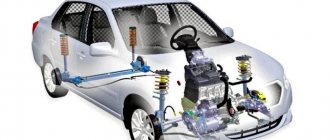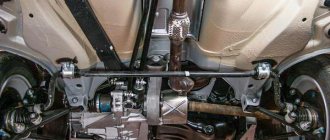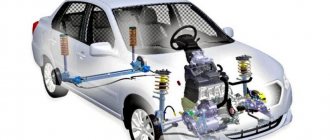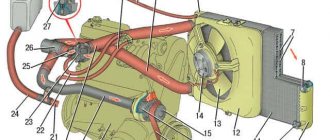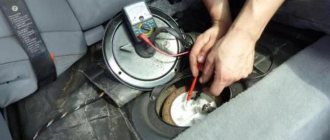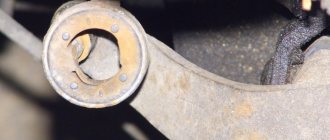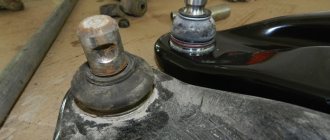Design aspects in such an element as suspension not only have a significant impact on driving comfort, but also determine the handling characteristics of the LADA Granta. The main suspension criteria that determine the owner’s choice are reliability and maintenance costs.
The LADA Granta model, popular today, belongs to the new generation of cars. When designing, the designers paid special attention to the chassis; in fact, the suspension itself was well designed.
Front suspension "Lada Grants"
It has an independent suspension with wishbones and a stabilizer bar. Damping of vibrations is carried out by hydraulic shock absorbers. The main structural element is the stand. It includes a swivel bearing, shock absorber and spring. The latter uses coils of variable diameter. The spring itself is made of a metal rod with a circular cross-section. It can have variable and constant hardness.
The front suspension of the Lada Granta is designed so that the lower part of the strut rests on the steering knuckle. When the wheels turn, the spring and shock absorber rotate with it. The stand itself remains motionless. Thus, the engineers achieved an increase in the service life of the elastic element while maintaining the inlet hole in the shock absorber body.
The pillar support has also been improved. Suspension creaking on the Lada Granta appears much less frequently than on Kalinas and Priors. To reduce roll, the design includes a stabilizer bar. It is made of spring steel. The stabilizer is installed with its ends to the lower suspension arms. Its middle part is fixed to the body.
Product description
Set of rear compression stroke buffers with boots and cups for VAZ 2110, 2170, Kalina, Granta
To confirm quality, each batch of products is subjected to a whole range of tests, which includes:
- determination of the elastic characteristics of products at temperatures of plus 23˚С and minus 40˚С;
- durability tests under cyclic compression at temperatures of plus 23˚С and minus 40˚С;
- determination of relative residual deformation after durability testing under cyclic compression;
- water absorption tests;
- impact brittleness testing by dropping a 20 kg load from a height of 1 meter at a temperature of minus 40˚C.
Rear suspension
Unlike the front, it has undergone virtually no changes. Here, just like on the first Soviet G8s, a semi-independent beam is used. It is attached to the body on hinges (fortunately, there are no “crabs” in the design). A helical spring with constant stiffness is used as an elastic element. To dampen vibrations and prevent swinging, two shock absorbers are used.
The elements come from the factory are oil type. The spring is fixed together with the shock absorber. This greatly simplifies maintenance work, but has a negative impact on handling. Often the rear axle skids when cornering. But despite the archaic design, the owners speak positively about this suspension and highlight a number of advantages:
- High reliability. The design does not have additional levers, which, in addition, can bend when falling into a large hole.
- Energy intensity. The Lada Granta absorbs all bumps perfectly, especially if oil shock absorbers are installed at the rear.
- Cheap maintenance. Due to its simple design, this pendant can be rebuilt even with your own hands. And the cost of new rubber-metal elements is unlikely to empty the pockets of even the most stingy car owner.
The main difference between the “Grant” suspension is the wheel alignment angles.
They have a positive camber of about 0.1°). On Priora, for example, this figure is -1 degree. Next, we will consider the main malfunctions of the chassis on the Lada Grant.
Innovations in the suspension system
Despite the different types of front suspension designs used (differences depend on the configuration), the developers took measures aimed at improving the performance indicators displayed by the front suspension. So the basic version of the Lada Granta served to create a modification with a more comfortable design of both elements - the front suspension and, accordingly, the rear suspension. Modernization includes:
1. Front suspension:
- the presence of a spring with an oversized coil diameter;
- gas-filled shock absorbers;
- reinforced longitudinal brace structures;
- increase in the diameter of the transverse stabilizer bar by a significant 2 mm.
2. Rear suspension:
- reinforced springs;
- gas-filled versions of shock absorbers.
An addition to the factory tuning was improved sound insulation. Due to these upgrades, the car began to confidently hold onto the road at increased speeds - up to 150 km per hour. Now sharp maneuvers in turns and bad surfaces are not a problem for him.
Shock absorber
This element is a damping device. The shock absorber serves to reduce the range of vibrations of the car body. In other words, the element prevents spontaneous rocking. The work of the shock absorber is based on hydraulic resistance. Inside it there is a liquid of a certain viscosity. It moves through a special valve. Thus, the device absorbs sharp impacts while preserving vulnerable suspension parts. Therefore, the shock absorber is one of the most important components in the chassis. On our roads, this element lasts about 60-80 thousand kilometers. But this period may be shorter, even with careful driving. It is enough just to damage the protective boot, and all the dirt will accumulate in the rod seal.
The rear shock absorbers suffer the most wear because they have much longer stroke. When driving quickly through potholes, the hydraulic fluid may simply boil. This is one of the reasons why a shock absorber fails. But most often it leaks - the valve loses its tightness due to a strong breakdown or impact. As a result, the outer side of the cylinder becomes coated with an oily liquid. How to determine that this element has failed? It’s very simple - you will hear a characteristic knock in the suspension of the Lada Granta. Moreover, it is clearly visible in the cabin. From the outside, you can hardly hear a broken shock absorber. This knock is so strong that even good music cannot interrupt it. You will hear a broken shock absorber immediately.
Also note that the damping element changes in pairs. That is, in the event of a breakdown of the rear left shock absorber, the rear right shock absorber also changes. As for the front struts, they are more durable. Often they are replaced already assembled with a spring, since they fail no earlier than after 150-200 thousand kilometers.
Analogues of the front / rear pillars of the VAZ-2190. Price
| Name / article | Price, rub.) |
| Pilenga SHP2791O / left | from 1400 |
| Pilenga SHP2790O / right | from 1400 |
| SS20 (СС20) SS20194 (front set) | from 3100 |
| Demfi | from 1400 |
| Elastomag | from 1400 |
| HOLA SH21-270G | from 1700 – 1800 |
| HOLA SH21-270 | —/— |
| HOLA SH22-270G | —/— |
| HOLA SH22-270 | —/— |
| HOLA SH40-270G | —/— |
| HOLA SH40-270 | —/— |
| Sachs 316763 rear set | from 2500 |
| Trialli AH01510 rear | from 1500 |
| Boge 30N87A rear kit | from 2500 |
*prices as of September 19, 2018.
Silent blocks
By 100 thousand, the silent blocks of the cross member and lower arms fail. Signs of a malfunction are a dull knock from the front suspension of the Lada Granta. Motorists recommend replacing these elements with polyurethane ones.
They are characterized by higher strength and good service life. At the factory, rubber silent blocks are installed that do not withstand the impacts of our roads. To replace, we need to press out the old element. First, the bead is cut off from it, and then knocked out using a mandrel or chisel. Pressing is done using a vice. It is important to maintain alignment and not mix up the installation side. For easier pressing, it is recommended to use lubricant.
The silent blocks of the anti-roll bar also fail. These bushings are also replaced with polyurethane ones.
Preparatory procedures
Repair of the front suspension (arms, balls, hubs) of VAZ 2114
Many car owners are interested in which racks are best to install, as well as how to do everything correctly. Before you repair the front struts, you will need:
- We stop the LADA Granta car using the handbrake and place wheel chocks under the stern wheels.
- Under the hood we find a shock-absorbing support rod, into the hexagonal recess of which, located at the end, we insert a key of the corresponding profile.
- Using the second wrench, we loosen the tightening torque of the nut securing the suspension element to the body. In the meantime, we use a hex wrench to keep the rod from trying to turn in conjunction with the nut.
- We “dive” into the wheel arch of the LADA Granta and find a bracket that holds the brake hose on the strut body.
- We unscrew the specified fastening unit, removing the hose itself from the holding bracket. This will provide space for unscrewing the lower point of the shock absorber strut. You will have to work in tandem with a key “17” size.
You should dare to replace the struts in cases where a leak of working fluid from the shock absorber is detected, as well as if there is a knock, deformation of the rod or destruction of the silent block.
You should remember the rule that implies replacing the struts as a whole on one axis, even if the second shock-absorbing element is in good condition.
Cause of malfunction
The main cause of element malfunction is a violation of the boot seal. Once it starts to crack, dirt and dust will get inside. They act on the ball like an abrasive. As a result, play appears and the support begins to break on its own. Is it possible to repair it? The Lada Granta suspension is designed in such a way that the ball joints cannot be restored and must be replaced entirely with new ones.
These elements are replaced as a set. The price of two balls is about 700 rubles. The service station will charge about 600 for installation. Although you can replace them yourself. All you need: a jack, a pit, a set of sockets and a special sprocket wrench. But please note that the bolts in this place may become sour. When replacing, there is a high risk of licking off the edges of the sprocket. Unscrew all bolts very carefully - do not press too hard. The service life of original ball joints is about 40 thousand kilometers.
Troubleshooting in the rack
Basically, the strut can make a knock and transmit impacts from uneven roads only when the entire structure is severely worn. Moreover, this element of the car suffers the most when the front pair of wheels falls into a deep hole - the rebound strut does not work, but the spring undergoes a sharp straightening. As a result, the wheel will go sharply down, stretching the spring to the maximum possible length. Thus, it turns out to be 2 hits - the racks against the support and the racks with the bottom of the pit.
Checking the functionality of the support pillar is carried out in a standard way - the vehicle is swung vertically or a partner presses forcefully on the central part of the hood. If the rack is in good condition, the body of the machine should return to its original state once without sharp straightening.
If the case falls sharply, you will hear a dull thud. This indicates a malfunction of the element due to a loose lock nut, which makes noise inside the support post itself. Repair of the rack should only be carried out at a car service center, since special equipment will be used to secure all elements in a high-quality manner.
If a knock occurs on small bumps due to the strut, the car sways strongly when moving and loses control. This may result in an accident on uneven roads.
Also, problems may lie not in the strut itself, but in the shock absorbers. A malfunction of the shock absorber system is primarily due to improper treatment with oil. Drivers often pour an oil solution with incorrect viscosity characteristics inside. This value is affected not only by the purchased oil, but also by the ambient temperature at which the solution is poured. Too low a temperature does not allow the oil fluidity to increase to the required value.
Wheel bearing
This element serves for uniform rotation of the car wheels. There are 4 such bearings on the Grant. On average, their resource is 100 thousand kilometers. What are the signs of a problem? The main symptom is a characteristic hum when moving. It may get worse as the car turns. The hum can occur on either side of the car, depending on which bearing has fallen apart. The entire assembly is replaced with a new one, and it doesn’t matter whether the Lada Granta’s rear suspension or the front one. It is pressed out using a puller with special paws. Pressing takes place in a vice. It is important to maintain alignment when pressing. If a bearing is installed crookedly, it will be subjected to high loads and may fall apart after just a thousand kilometers.
The main enemy of a bearing is moisture. Therefore, during installation it is so important to ensure the element is sealed. Some manufacturers cover it with a special cap (it is put on the fastening nut), which will prevent salt, water and other reagents from getting inside. But as soon as dust penetrates the bearing, the latter begins to operate outside of its temperature range. As a result, the lubricant is washed away, and the dirt acts as an abrasive. Untimely replacement of this element can provoke a sudden wheel wedge, which is fraught with consequences.
Removing the Grant strut
If, during the process of repairing a strut on a Lada Granta, you come across the fact that your car’s brakes have an anti-lock braking system, be sure to remove the sensor responsible for the frequency with which they rotate.
Then proceed to disconnect the tie rod. This procedure must be performed in conjunction with removing the tip of the strut swing arm. To ensure that during the work there is no significant violation of the angles at which the Lada wheels are installed, be sure to mark where exactly the highest bolt and the same washer are located. The entire procedure can be performed using an ordinary marker. This action will help you in the future to achieve the correct position of the bolt relative to the racks so that the Lada does not start to move to the side when moving.
The nuts securing the racks must be unscrewed carefully to prevent them from falling.
Unscrew the nut from the bolt that attaches the Lada Grant strut directly to the steering knuckle. Once you have completed this procedure, begin removing it in such a way as to grab the eccentric washer at the same time. Now unscrew the lower nut securing the strut. It is located in close proximity to the steering knuckle. Once you have the mount loosened, remove the bolt. Disconnect the steering knuckle from the strut.
Next, look under the hood. In front of your eyes there are three nuts, thanks to which the support is attached to the body
They must be unscrewed sequentially and carefully, holding the stand so that it does not fall under any circumstances. All work is done using a 13 key
After unscrewing the nuts, we take out the stand.
We take the spring ties and install them on the spring, always opposite each other. After this, turn the tie screws evenly until the spring begins to dangle. When it stops pressing on the support cups, using a 22mm wrench, unscrew the rod nuts. Once the nuts are unscrewed, you can disassemble the stand itself. We take out the strut support along with the bearing, remove the metal cup and damper. What remains is the spring and the boot with the bump stop.
